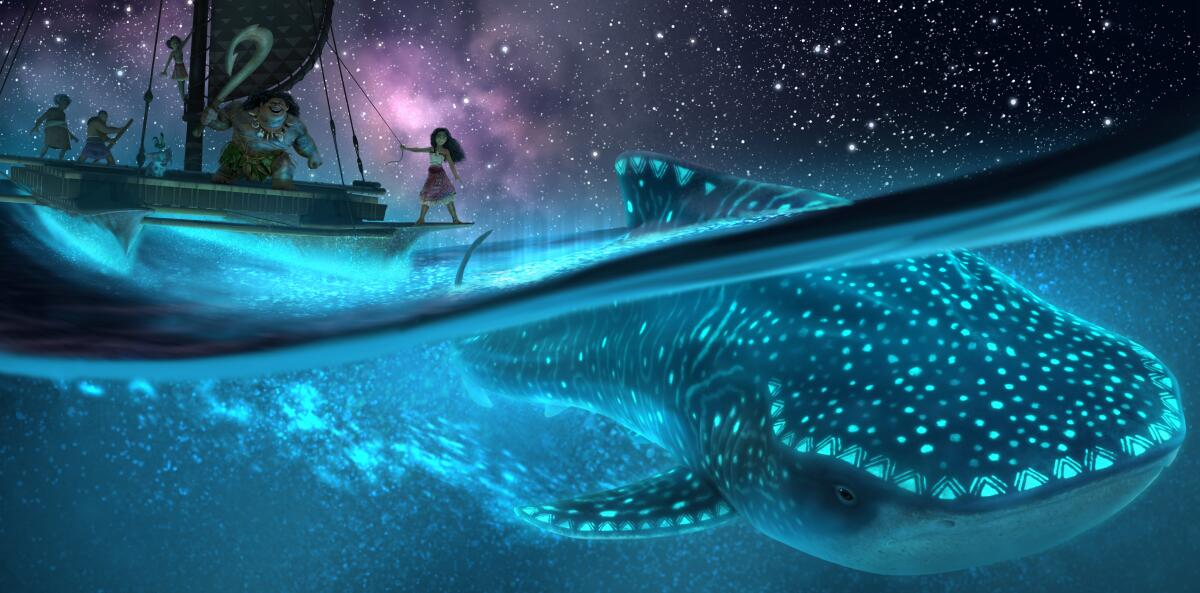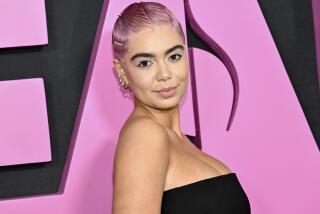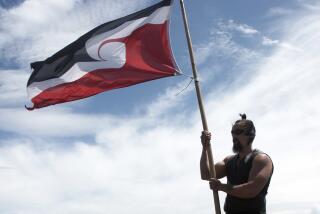The cultural significance of the catchy ‘Moana 2’ song ‘Can I Get a Chee Hoo?’

“Can I get a Chee Hoo?”
It’s a question that the demigod Maui tunefully poses to the titular princess in “Moana 2.” But this seemingly simple request is steeped in cultural tradition, notable in narrative context and, given its catchy hook, likely to become Disney’s next inescapable earworm.
The charismatic composition — performed with gusto by Dwayne Johnson — is indeed worth shouting about, especially on the heels of the beloved numbers of the 2016 movie, which were written by Lin-Manuel Miranda, Mark Mancina and Opetaia Foa‘i. “The first one was great to introduce this culture to the world, and I’m very proud of what we achieved,” said Foa‘i.
“The songs of a second movie have got to be either as good as the first movie or better,” said Mancina, who co-wrote the sequel‘s songs with Foa‘i, Abigail Barlow and Emily Bear. “If they don’t have integrity, kids can tell: This is just a money grab.”
Hey, Hollywood, don’t throw the baby, or at least the 8-year-old, out with the bathwater. Strong ‘Wicked’ opening shows family movies are more in demand than ever.
The animated adventure picks up three years after the events of the first movie: Moana, now a seasoned “wayfinder,” respected community leader and an older sister, answers a call from her ancestors to venture further than ever before, all to try to secure her island’s future well-being.
“This time, the story also is all about that aspect of growth of trying to plan where you’re going and wanting to stay the exact course, but really understanding that life will throw curve balls and challenges your way, and you can lean on your crew to help you through it,” said returning actor Auli’i Cravalho, who voices Moana.

A standout song, “Can I Get a Chee Hoo?” is performed more than halfway into the movie, when Moana is deeply discouraged about facing Nalo, the god of storms.
“In the first movie, Maui met Moana when he was at his lowest and most vulnerable, and she empowered him and helped him reach his full potential,” said David Derrick Jr., one of the sequel’s three directors. “We wanted Maui to return that favor to Moana, but in the most entertaining way possible.”
“Can I Get a Chee Hoo?” is an upbeat, percussion-driven track with shades of a rock anthem that also offers a retro instrumental solo (a blend of a jazz flute and various synths, delivered by Maui via fire conch). It was the last song written for the movie, replacing another number that didn’t quite reflect where Moana was in that moment, or how much Maui cares for her.
“Everything we were doing was either too cheesy or abstract, or it sounded like a s— motivational speech that we were copying from YouTube,” said Bear. “How do we make this cool and not cringy, and still authentic to this character and his friendship with Moana?
“When I’m at my lowest and I feel like nothing anyone will say to me will make me feel better, I don’t need a motivational speech, I need a dose of reality,” Bear continued. With this song, “Maui essentially tells Moana, ‘Stop doubting yourself, because the enemy you’re up against doesn’t doubt you. He wouldn’t waste his time trying to stop you if they didn’t think you were capable of beating him.’”

Maui musically lifts Moana up by reminding her of who she is, applauding her innate greatness and then challenging her to do the same for herself. How? “With a rallying cry of epic proportions,” said Barlow.
This specific phrase — already exclaimed often by Maui throughout the first film — is a fa’aumu or an expression of emotion in Samoan culture, and it holds great significance throughout Pacific Island communities at large.
“I think how it’s represented in the film reflects how it’s actually used today,” said Grant Muāgututi’a, a Samoan linguist and dialect coach who worked on the movie. “It’s like your heart’s showing. The most common contemporary use is to show support at a special occasion — a performance, a football game, a wedding or a funeral.”
“It’s such an important celebratory cheer, like our version of ‘hip hip hooray,’” added Cravalho. “As soon as fireworks go off on New Year’s Eve, you can hear Chee Hoos all across the island. It’s almost like a call-and-response. Any time there’s a graduation and there is a Pacific Islander who steps up onstage, you can bet we are Chee Hoo-ing the loudest.”
The “Moana 2” song adopts this Pacific Islander greeting as a life ethos, similar to how “Hakuna Matata” frames a Swahili translation as a personal motto in “The Lion King.” “We wanted to make sure that nothing we do is too silly,” said Mancina, who worked on both songs, “but that it’s still really fun.”

Adapting the culturally significant phrase for an anticipated Disney movie initially made co-director Dana Ledoux Miller nervous.
“It’s something I take very seriously and have had a lot of conversations about, mostly because I wanted to make sure that, in using it, it was a celebration and used in a positive way,” she said. “Knowing that it would mean a lot to a lot of people, we didn’t want to get it wrong. It was exciting to be able to move with that mindfulness through this collaboration and create something that’s so fun. I feel so proud of the care that we took in this.”
In order to get it all right, “Moana 2” directors Derrick and Ledoux Miller — both of whom are of Samoan descent — and Jason Hand created the film with numerous culturally authentic elements, thanks to the movie’s Oceanic Cultural Trust, a group of 13 experts in anthropology, history, movement, canoes and navigation, linguistics and various cultural practices.
Ariana Grande proves herself a ‘modern-day Lucille Ball’ with ‘Popular,’ the funniest number in ‘Wicked.’ The film’s creative team explains how it all came together.
“I think that, by showing more moments where we lean into the specificity of culture, the audience leans in too, because it grounds our story in a real way,” said Derrick. To him, a song like “Can I Get a Chee Hoo?” is proof that “being specific with culture doesn’t have to be a weighty moment. It can be uplighting and fun and joyous.”
“It’s awesome to be part of all these brilliant minds, working together to make the movie as resonant and respectful as possible,” added Muāgututi’a, a member of the Oceanic Cultural Trust. “When things like ‘Chee Hoo’ are shared in a way that’s accurate and inclusive, it’s less appropriation and more appreciation. It’s all love.”
The trust consulted on many key moments that illustrate Moana’s culture as well as her character‘s growth: her participation in a kava ceremony for a new title, the further progression of her wayfinding abilities and her pivotal performance of a haka, a ceremonial dance and chant. “I’ve never done a haka before, so I was so into it,” said Cravalho of filming the scene. “I put my whole chest into it and it felt so good!”

And in “Can I Get a Chee Hoo?,” Moana is shown performing siva afi, or fire-knife dancing. “It’s something that you only see men do,” said animation reference choreographer Tiana Nonosina Liufau. “When I was physically doing it [as a model for the film’s animators], I really felt so empowered. So to think about Moana doing it in this moment when she’s feeling down, and especially that you don’t usually see women doing it, I think she leaves that song feeling a lot of power.”
“We were obsessed with getting that right,” said Hand of replicating Liufau’s physicality for the fire-dancing sequence. “Those moves all mean something, so it’s really important to do it properly. Our animators really paid close attention to all that work that she did.”
According to Hand, Johnson “got goosebumps when he first heard” “Can I Get a Chee Hoo?” In the recording booth, Bear encouraged the actor to imagine he was singing directly to his daughter: “If you saw her in this position, how would you want to deliver this message to her? It’d be full of heart.”
With “Moana 2” now in theaters, “We’re probably going to see a lot of young kids shouting ‘Chee Hoo’ all over the place,” said Foa‘i with a laugh. For Moana actor Cravalho, that’s a thrilling thought.
“I’ve had a decade with this character, and the impact she continues to have is almost overwhelming for me,” she said. “It’s truly so important to see a young woman be the hero of her own story, and I feel great pride that our specificities get shared with the masses because Disney puts them on a larger platform. So to people who are not of Pacific Island descent but still find themselves in this character or other characters in this film, I say thank you.”

More to Read
Only good movies
Get the Indie Focus newsletter, Mark Olsen's weekly guide to the world of cinema.
You may occasionally receive promotional content from the Los Angeles Times.













